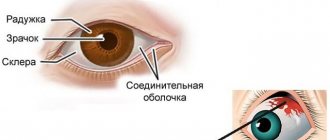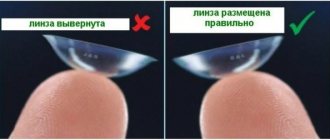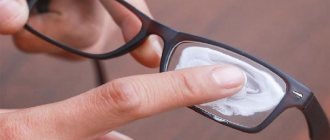Many people are hesitant to give up glasses and switch to contact lenses due to various concerns: the lens may get stuck under the eyelid, tear, or roll behind the eyeball. In the article, we will consider whether such situations are really real and how to avoid discomfort when wearing contact correction products.
In many ways, such fears are fueled by incorrect information gleaned from various forums. You should not believe in myths from the Internet that do not correspond to the facts at all. It is better to obtain information from specialized sites and trusted sources.
Can a lens roll behind the eyeball? This is a common question that many people want an answer to. To find out this, we should take a closer look at the anatomical structure of our visual organs.
Can a foreign body get behind the eye?
Between the eyeball and the orbit itself there are various connective tissues and structures:
- conjunctiva;
- Tenon's capsule;
- eye muscles;
- fat layer.
Behind the conjunctiva is the conjunctival sac. In front (with the eyelids closed), the orbit is limited by the tarso-orbital fascia, which is woven into the cartilage of the eyelids and fuses with the periosteum along the edge of the orbit. Of course, all these layers do not allow the contact lens to penetrate behind the eyeball - this is physiologically impossible. Even if you try to do this purposefully, the person will experience nothing but pain, and the lens will never get behind the eye.
So can the lens roll behind the eyeball? The answer is clear - no. But some troubles can still happen when wearing contact optics. Let's consider such situations.
How to find a lens that fell on the carpet
All MKLs (with the exception of ) are completely transparent or have a slight, barely noticeable tint, which makes them extremely difficult to detect on the carpet. Moreover, they are very light and can float in the air like “flying saucers.” Such lenses are capable of falling in the most unexpected places without making a single sound. Naturally, searching for them can be very difficult.
You can find a lens that has fallen on the carpet or floor using a vacuum cleaner. Before starting the search, you should put a thin nylon stocking on its nozzle. This will allow you to “scan” the area of the floor where the MCL may have fallen. To avoid accidentally damaging the lens, during searches you need to carefully move the vacuum cleaner at a distance of 2-3 cm from the floor. When the “lost” is on the surface of the stocking, you can turn off the vacuum cleaner and pick it up from there. Afterwards the lens can be worn again.
How to remove a stuck lens from under the upper eyelid?
The lens can get under the upper eyelid in the following cases:
- the model is incorrectly selected;
- with increased dryness of the organs of vision;
- if you rub your eyes too hard with your hands.
This happens especially often with those who are new to wearing optics. However, there is no reason to panic in this case: the lens is not fraught with danger if you carefully remove it. She still won’t be able to get behind the eyeball. What can be done to remove the lens from under the upper eyelid? First, you need to try to blink frequently - from such movements it should return to its place on its own. If this does not help, then use moisturizing drops: put 1-2 drops into the eye, pulling back the lower eyelid, then blink frequently. If these manipulations are not successful, then you need to close the eyelid and, with careful massaging movements, try to move the lens to the inner corner of the eye. Usually one of the methods definitely helps.
In general, plenty of fluid and gentle massage of the eyelids towards the inner corner of the eye will usually help dislodge a lens stuck under the eyelid. If this cannot be done, then you need to promptly visit an ophthalmologist - he will help you cope with the problem. If the lens remains behind the eyelid for a long time, there is a risk of developing conjunctivitis. To avoid a recurrence of such a situation, you must adhere to all recommendations for wearing lenses and carefully select them in accordance with the prescription from your ophthalmologist.
Common Causes
The main problem that some users face today is incorrect selection. This often happens to those who neglect the recommendations of the attending physician or completely refuse to visit him. If the base curvature was chosen incorrectly, the product will not fit tightly, which can lead to its further loss. In addition, how comfortable the correction device will be located largely depends on the material used in production.
For example, hydrogel optical products, characterized by a high moisture content, may not immediately take the required position and are more at risk of loss than others. In this regard, silicone hydrogel lenses for the eyes are considered more practical, which, according to ophthalmologists and users themselves, are much easier to handle and usually do not cause such problems. Another challenge that beginners may encounter is maintaining proper donning technique. The fact is that when you bring the correction agent to the organs of vision, a protective reflex may be triggered, consisting of rapid blinking. Because of this, it may not have time to take the required position on the cornea and, as a result, get lost.
What to do if the lens breaks in the eye?
This situation can occur if you carelessly touch a thin soft lens with long nails, as well as for other reasons. This is why it is better to remove contact optics with a suction stick rather than with your hands. If the lens breaks, small pieces of polymer may remain in the eye. To remove them, you need to apply a generous amount of moisturizer (you can even use a universal solution for lenses), and then run your finger over the eyelid with massaging movements, trying to move the pieces down and towards the corner. If after some time discomfort still appears, then you should immediately visit an ophthalmologist to check your visual organs. Polymer residues can cause various eye inflammations.
Signs and symptoms of a lens that has rolled behind the eyeball
Corrective and decorative models have the correct anatomical structure and are comfortably installed on the cornea. When the product is displaced from the iris area, a number of signs appear that cause severe inconvenience. The main ones are:
- foreign body sensation;
- incessant itching;
- pain in the eyes, burning, pain;
- dryness;
- difficulty blinking;
- decreased visual acuity.
In addition, the problem may be accompanied by increased tearing, redness and redness of the eyes. Unpleasant sensations appear from the first minutes after displacement and can lead to the development of serious ophthalmological diseases. Read about eye drops for eyes from computer fatigue here.
When choosing a lens to correct children's vision, the first installation should be supervised by an adult. This will help avoid unpleasant problems and common mistakes.
For what reasons can a lens feel like a foreign body in the eye?
It happens that new users feel the lens like a foreign body in the eye, experiencing discomfort during use. Experts explain the reasons that can cause such sensations:
- A dirty or damaged lens scratches the inside of the eyelid, rubbing it and causing watery eyes. Neglect of regular care can lead to severe contamination of the surface, which will create a favorable environment for the proliferation of pathogenic microorganisms.
- Incorrectly selected model according to parameters. Lenses that are too large in diameter or radius of curvature will slide off the cornea, interfering with good visibility, and rubbing the inner surface of the eye.
- Incorrect lens position. Before putting it on, make sure it is not turned backwards. The lens should look like a smooth hemisphere, and not a flat bowl with bent edges. Some models (for example, ACUVUE) have special markings that indicate the correct position.
Even if the lens is lost in the eye, there is no need to panic: it will not be able to roll behind the eyeball. When positioned correctly, the lenses usually sit comfortably on your eyes all day long and do not cause discomfort. To avoid unpleasant situations during operation, you should choose a model in accordance with the ophthalmologist’s prescription.
Can a contact lens get stuck in the eye?
Can a contact lens get lost in the eye? The lens certainly cannot disappear without leaving a trace in the eye. It can, for example, roll under the upper eyelid. This is not critical, and there is no need to panic in this situation. Under no circumstances rub your eye while trying to move it. The eyelid will still “lift” the lens upward. You need to calm down and do the following:
- Wash your hands thoroughly. Remember that all actions with the eyes should be performed only with perfectly washed hands.
- Sit in front of a mirror, provide good lighting, raise your chin almost horizontally and pull down your upper eyelid. If the lens is still not visible, then apply moisturizing drops and blink for 2-3 minutes. This will help the lens slide down, and you will definitely see it.
- Try to carefully grab the lens with tweezers and pull it out of the eye. And don’t worry that it will roll over the protein – the connective tissue simply won’t allow this to happen.
If you still do not find the lens after all these steps, perhaps it simply fell out of your eye, for example, while taking a shower. Just in case, you can go to the ophthalmologist to make sure that it is not in the eye.
What to do if the lens breaks on your eye? Yes, it also happens that a thin lens breaks right in front of the eye. This usually happens if the eye is too dry or the size is incorrectly selected - there can be various reasons. When ruptured, particles of polymer material remain on the cornea. They can injure it or move under the eyelid. In this case, you should drop a large number of moisturizing drops into the eye, carefully remove the pieces and blink well so that the particles come out from under the eyelid with the liquid. Then carefully remove the residue with a cotton swab soaked in a moisturizing solution. But if you are not completely sure that all the remains have been removed, it is still better to visit an ophthalmologist.
The lens is stuck to the cornea, what should I do? If the lens suddenly stops moving and sticks to the eye, immediately apply a lubricating or moisturizing solution recommended by your doctor. If this does not help, then immediately contact a specialist.
As you can see, when wearing lenses, unpleasant situations may arise related to their removal. There is no need to panic; it is important to try to remove the rolled or torn lens in time; it should not remain there for a long period of time. And always remember the rules of hygiene when you remove or put on lenses - many problems arise precisely because of non-compliance with these simple rules. Only you yourself are responsible for the health of your eyes!
Causes
Manufacturers produce different models of lenses. Some are designed for one-day use. Others suggest use for 2-3 months (washed every day with a special solution and stored in containers at night).
Still others are designed for multi-day wear (soft lenses that can be worn for up to 1 year, removed from time to time to clean protein deposits).
People suffering from visual impairments can select suitable matrices without any problems if they first visited an ophthalmologist who gave the necessary recommendations and accurately selected lenses according to curvature and diopters.
And it seems that the problem has been solved, but at an unexpected moment one of the lenses or both dry out at once, and the person does not know what to do next? This happens for the reasons described below.
Products are stored in an open container
It is unacceptable to store lenses in an open container, much less in a room with low humidity. As a result, the solution evaporates and the lenses become dry.
Violation of the rules for using lenses
A man stands in front of a mirror that has no shelf. One careless movement of your fingers, and the transparent matrix flies to the floor.
With severe visual impairments, finding a lost product becomes a big problem - this sometimes takes several hours. Sometimes searches do not yield any results, and you have to purchase new lenses.
This includes any careless handling of lenses and their storage container, which causes them any defects.
They, as well as debris and dust, can cause tingling, rubbing, burning, and severe pain in the eyes. Because of them, a person takes off and puts on lenses once again.
Incorrectly selected lens option
If the lens is curved in an inappropriate way, its curvature is incorrectly selected, an error occurs in determining the diopters, after 10-15 minutes the person unconsciously tries to get rid of it: he scratches and rubs the eye, closes his eyelids, and blinks quickly.
As a result of this activity, the matrix moves away from the pupil and falls. While the owner is looking for her, she dries out and becomes very fragile.
Ignoring doctor's recommendations
Some people ignore their doctor's recommendations and rest at night without removing their lenses. This can lead to loss and drying out of a product that is not designed for long-term use.
Much less often, such problems are encountered by those buyers who strictly follow the doctor’s advice and are not lazy to disinfect and clean products in a timely manner.
Can a lens get lost in the eye and why?
The first thing to remember is that the selection of contact correction means should be carried out with the help of an ophthalmologist. After all, this is a product that is suitable only if it was selected by a specialist and took into account all the unique features of the future owner of the lenses. Manufacturers make different types of lenses, which differ in radius and depth of bend. If they are chosen correctly, they follow the shape, are in close contact with the eye socket and do not move on their own. But there are a number of reasons why sliding on the cornea can occur:
- If you press or scratch your closed eyelid with force, it can get stuck behind it. Mainly behind the top.
- Little specks. A damaged product provokes pain and does not allow it to fit tightly to the cornea, and this, in turn, is one of the reasons for displacement.
- A contact lens can get stuck under the eyelid if the shape or size is incorrect.
- If put on the wrong way, it can cause displacement.











